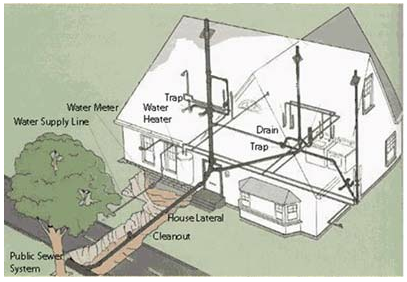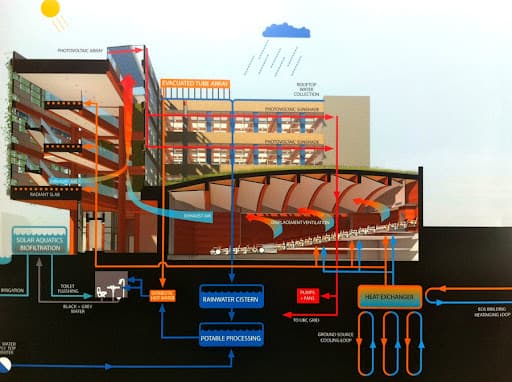Examining Your House's Plumbing System Anatomy
Examining Your House's Plumbing System Anatomy
Blog Article
What are your opinions on Exploring Your Homes Plumbing Anatomy?

Recognizing just how your home's plumbing system works is crucial for every single homeowner. From supplying tidy water for drinking, cooking, and showering to securely eliminating wastewater, a well-kept plumbing system is crucial for your family members's health and wellness and comfort. In this comprehensive overview, we'll explore the intricate network that makes up your home's plumbing and deal tips on upkeep, upgrades, and taking care of common issues.
Introduction
Your home's plumbing system is greater than just a network of pipelines; it's a complex system that ensures you have accessibility to tidy water and reliable wastewater removal. Recognizing its parts and exactly how they collaborate can assist you stop expensive repair work and make certain every little thing runs smoothly.
Standard Parts of a Pipes System
Pipelines and Tubing
At the heart of your plumbing system are the pipelines and tubing that lug water throughout your home. These can be constructed from various materials such as copper, PVC, or PEX, each with its benefits in terms of sturdiness and cost-effectiveness.
Fixtures: Sinks, Toilets, Showers, and so on.
Components like sinks, commodes, showers, and bathtubs are where water is used in your house. Comprehending how these components attach to the pipes system assists in diagnosing problems and intending upgrades.
Valves and Shut-off Factors
Shutoffs manage the flow of water in your pipes system. Shut-off valves are crucial throughout emergencies or when you need to make repair work, allowing you to separate parts of the system without interrupting water circulation to the whole residence.
Water System System
Main Water Line
The major water line attaches your home to the local supply of water or a private well. It's where water enters your home and is distributed to various components.
Water Meter and Pressure Regulatory Authority
The water meter steps your water usage, while a stress regulatory authority guarantees that water moves at a secure pressure throughout your home's plumbing system, protecting against damages to pipelines and fixtures.
Cold Water vs. Hot Water Lines
Recognizing the difference between cold water lines, which provide water straight from the major, and hot water lines, which bring warmed water from the water heater, assists in troubleshooting and planning for upgrades.
Drain System
Drain Pipeline and Traps
Drain pipelines carry wastewater away from sinks, showers, and commodes to the sewage system or sewage-disposal tank. Traps protect against drain gases from entering your home and additionally catch debris that can cause blockages.
Air flow Pipelines
Air flow pipelines permit air right into the drainage system, protecting against suction that could slow water drainage and cause catches to empty. Appropriate ventilation is necessary for maintaining the stability of your pipes system.
Value of Correct Drainage
Making sure correct drainage avoids back-ups and water damage. Frequently cleaning drains pipes and preserving catches can prevent costly repair work and extend the life of your plumbing system.
Water Heating Unit
Kinds Of Water Heaters
Water heaters can be tankless or standard tank-style. Tankless heating units warm water on demand, while storage tanks keep warmed water for instant use.
How Water Heaters Connect to the Plumbing System
Understanding how water heaters attach to both the cold water supply and hot water distribution lines helps in detecting concerns like inadequate hot water or leaks.
Maintenance Tips for Water Heaters
On a regular basis purging your hot water heater to eliminate sediment, checking the temperature setups, and checking for leaks can expand its life-span and enhance energy efficiency.
Common Pipes Problems
Leaks and Their Reasons
Leakages can occur due to aging pipelines, loosened fittings, or high water stress. Attending to leaks without delay protects against water damages and mold development.
Blockages and Blockages
Obstructions in drains pipes and commodes are typically caused by purging non-flushable things or a build-up of grease and hair. Utilizing drain displays and being mindful of what drops your drains can prevent blockages.
Indications of Pipes Issues to Watch For
Low tide pressure, slow-moving drains, foul odors, or unusually high water bills are indicators of prospective plumbing troubles that should be dealt with immediately.
Pipes Upkeep Tips
Routine Assessments and Checks
Schedule yearly plumbing inspections to catch issues early. Search for indications of leakages, rust, or mineral accumulation in taps and showerheads.
Do It Yourself Maintenance Tasks
Straightforward tasks like cleansing faucet aerators, checking for bathroom leakages using color tablets, or shielding exposed pipes in cool climates can protect against major plumbing issues.
When to Call an Expert Plumbing
Know when a pipes concern requires professional expertise. Attempting complicated repairs without proper understanding can bring about more damages and greater repair expenses.
Updating Your Pipes System
Reasons for Updating
Updating to water-efficient fixtures or changing old pipes can improve water high quality, reduce water costs, and enhance the worth of your home.
Modern Pipes Technologies and Their Benefits
Explore technologies like clever leak detectors, water-saving commodes, and energy-efficient water heaters that can save cash and minimize ecological influence.
Expense Factors To Consider and ROI
Calculate the ahead of time prices versus lasting savings when thinking about plumbing upgrades. Several upgrades spend for themselves with minimized utility bills and less fixings.
Ecological Influence and Conservation
Water-Saving Fixtures and Home Appliances
Setting up low-flow taps, showerheads, and commodes can considerably decrease water usage without compromising efficiency.
Tips for Lowering Water Use
Easy habits like repairing leakages without delay, taking much shorter showers, and running complete tons of laundry and meals can save water and lower your utility bills.
Eco-Friendly Plumbing Options
Consider lasting plumbing materials like bamboo for floor covering, which is durable and eco-friendly, or recycled glass for kitchen counters.
Emergency situation Preparedness
Steps to Take Throughout a Pipes Emergency
Know where your shut-off valves lie and exactly how to turn off the water supply in case of a burst pipeline or significant leak.
Importance of Having Emergency Situation Get In Touches With Convenient
Keep get in touch with info for regional plumbing professionals or emergency situation solutions conveniently offered for quick feedback throughout a plumbing crisis.
Do It Yourself Emergency Situation Fixes (When Applicable).
Short-lived repairs like using air duct tape to patch a dripping pipeline or putting a pail under a leaking faucet can lessen damage till an expert plumbing gets here.
Final thought.
Understanding the composition of your home's plumbing system equips you to keep it properly, saving money and time on repair work. By adhering to regular upkeep routines and remaining informed regarding modern-day plumbing modern technologies, you can ensure your plumbing system runs efficiently for years ahead.
HOW YOUR PLUMBING SYSTEM WORKS
Which Pipes Do What?
Blue lines = fresh water supply entering the building
Red lines = hot water supply entering the building
Grey lines = pipes carrying waste away from the building and venting pipes carrying gases away from the building (through the roof)
YOUR MAIN PLUMBING SYSTEMS
There are two main plumbing systems that support your home s basic plumbing needs one that brings clean water into your home, and one that sends dirty water away from your home. Connected to the toilet, bath, shower, and other faucets in your home, these two systems keep your water flowing in the right directions.
ACCESSING FRESH WATER
Fresh and clean water is brought into your home through the main water supply line . Filtered through one pipe, this water is pressured to flow into the various fixtures in your home at any given time.
This water can be sourced from a well located on your property, a pond or river (mostly cottages), or, as in most cases, from the city s municipal water treatment centre. However, it is important to note that water that is untreated, such as the water siphoned from ponds or rivers, may not be safe to drink. Personal water supplies always need to be treated for hardness and contaminants before consumed.
MUNICIPAL WATER SUPPLIES
Improve taste and odour
Remove sediment
Eliminate hardness
Reduce chlorine
COLD WATER SUPPLY VS. HOT WATER SUPPLY
Cold water flows into your home or building through the service line, which then distributes hot or cold water to your fixtures. This line is most commonly run through a central column that runs floor to floor. Hot water runs in short and straight pipes as the longer the pipeline, the more heat that will be lost in the transfer. Having shorter pipes also allows residents to access hot water more quickly.
WASTE WATER SYSTEM
Your wastewater system is divided into two parts pipes that send wastewater away from your home and venting pipes that send sewer gas away from your home. Sewage water travels through pipes that flush the water and waste towards local sewers that are operated and managed by your city or town. Most sewer systems rely on gravity to move the wastewater to where it needs to go.
The further away from your toilet or sink, the larger wastewater pipes become. This allows for waste to be disposed of from various parts of your home or business at once without pipe blockages. The angle and flow of these pipes are also essential for keeping your waste pipes clear of build up.
https://harrisplumbing.ca/how-your-home-plumbing-system-works/

HOW YOUR PLUMBING SYSTEM WORKS
Which Pipes Do What?
YOUR MAIN PLUMBING SYSTEMS
There are two main plumbing systems that support your home s basic plumbing needs one that brings clean water into your home, and one that sends dirty water away from your home. Connected to the toilet, bath, shower, and other faucets in your home, these two systems keep your water flowing in the right directions.
ACCESSING FRESH WATER
Fresh and clean water is brought into your home through the main water supply line . Filtered through one pipe, this water is pressured to flow into the various fixtures in your home at any given time.
This water can be sourced from a well located on your property, a pond or river (mostly cottages), or, as in most cases, from the city s municipal water treatment centre. However, it is important to note that water that is untreated, such as the water siphoned from ponds or rivers, may not be safe to drink. Personal water supplies always need to be treated for hardness and contaminants before consumed.
MUNICIPAL WATER SUPPLIES
COLD WATER SUPPLY VS. HOT WATER SUPPLY
Cold water flows into your home or building through the service line, which then distributes hot or cold water to your fixtures. This line is most commonly run through a central column that runs floor to floor. Hot water runs in short and straight pipes as the longer the pipeline, the more heat that will be lost in the transfer. Having shorter pipes also allows residents to access hot water more quickly.
WASTE WATER SYSTEM
Your wastewater system is divided into two parts pipes that send wastewater away from your home and venting pipes that send sewer gas away from your home. Sewage water travels through pipes that flush the water and waste towards local sewers that are operated and managed by your city or town. Most sewer systems rely on gravity to move the wastewater to where it needs to go.
The further away from your toilet or sink, the larger wastewater pipes become. This allows for waste to be disposed of from various parts of your home or business at once without pipe blockages. The angle and flow of these pipes are also essential for keeping your waste pipes clear of build up.
https://harrisplumbing.ca/how-your-home-plumbing-system-works/
I hope you enjoyed reading our topic about The Inner Workings of Your Home's Plumbing. Thank you so much for finding the time to read through our article. Be sure to take a moment to distribute this blog post if you appreciated it. Thanks a lot for going through it.
Click Here Report this page